AUTUMN, WINTER, SPRING Tours in NORTHEAST INDIA
Northeast India offers superb wildlife & birding trips
World Heritage Site Kaziranga National Park
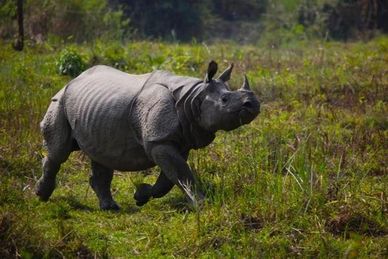
Kaziranga National Park is spread over 430 sq kms as its core area bordered on the north by the Brahmaputra River and on the south by the Karbi Anglong hills in central Assam. The largest number of one-horned rhinoceros in the world roams its swamps, grasslands with tall thickets of elephant grass and areas of mixed deciduous and tropical semi-evergreen forest making it the world's best place to spot these majestic beasts. It is also home to a wide variety of other animals and birds. India's Big 5 are found in Kaziranga alone - Rhino, Elephant, Asiatic Water Buffalo, Sambar Deer and the Tiger. There are numerous other mammals and birds, including the rare greater adjutant stork, Bengal florican, eagles, hornbills and many more besides thousands of migratory birds seasonally attracted to the park from as far away as Siberia. Divided into 4 ranges that form the core area of 430 sq km, there are a number of ‘additions’ that make up a buffer zone for the park.
Wild life viewing: We recommend at least 3 nights/ 4 days stay at the park to explore all the different ranges which will allow you to absorb what this World Heritage Site national park has to offer the wildlife enthusiast and nature lover and also what it means to the people who protect it. Jeep safari is the best way to go deep inside the park. 4X4 open jeeps do a morning and afternoon safari with a break of 2 hours at noon. These safaris last for 3 to 5 hours each depending upon the daylight hours. An one hour elephant safari can also be done with prior booking days ahead of your visit. Naturalists and guides are provided from our side.
Nameri National Park, Birders' Delight
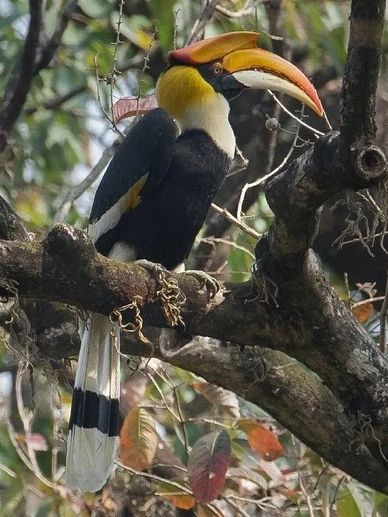
The Nameri National Park, with an area of 200 sq km area is located in the north-central part of Assam bordering Arunachal Pradesh. Nameri forms part of a contiguous forest belt comprising of Eagle’s Nest wildlife park to the northwest and Pakke wild life park to its north. The swift flowing Jia Bhorelli River coming down from the Arunachal Pradesh hills forms the southern boundary of the park.
The vegetation is semi-evergreen, moist deciduous forests with cane and bamboo and narrow strips of open grassland along rivers. This is excellent elephant country. It is also an ideal habitat for a host of other animals including the tiger, leopard, the very rare and endangered Pygmy Hog, Gaur or the Indian bison, wild boar, Himalayan black bear, capped langur and the Indian giant squirrel.
Nameri has over 300 species of birds. Among the rarest that you might get to see is the white winged wood duck. Vultures are a vanishing breed, but you can still expect to see the white ramped and the long billed vulture here. Hornbills show up on occasions. Apart from these the black-necked stork, Pallas’ fish eagle, ibis bill, bee-eaters, babblers, plovers and many other birds make Nameri their home.
Wild life viewing: From the periphery of the park where accommodation facilities are located and as you go about 2 km towards the Bhorelli River, you begin to feel the impact of the forest. There is good birding scope even along the southern bank of the river. There are wooden canoes to take you to the other side of the river from where you can trek into the core area of the park. The trek is always accompanied by forest guards; we provide naturalists from our side. This park can also be enjoyed by floating down the Bhorelli River on rafts – you have your hands free to take pictures as expert boatmen steer your raft.
The recommended stay is for 2 nights/ 3 days at the park for activities like trek inside the core area, rafting and nature walks.
Eagle's Nest Wildlife Sanctuary, Rarities & Endemic Birds
Eagle's Nest Wildlife Sanctuary, Rarities & Endemic Birds
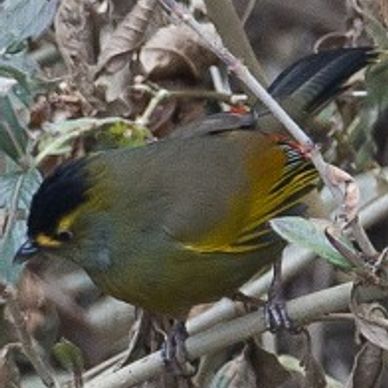
Rising from 500 m to 3200 m altitude with an area of 218 sq km the Eagle Nest Wildlife Sanctuary in west Arunachal Pradesh hosts one of the finest birdlife assemblages that Asia has to offer. Ward’s trogon, wedge-billed and rufous-throated wren-babblers, rufous-necked, great and wreathed hornbills, black-necked crane, beautiful nuthatch, emerald cuckoo are some of the most sought after birds. Not to mention our most prized species, the Bugun Liocichla, the bird that brought Eagle’s Nest to world attention in 2006. Because of the altitudinal difference within a small area we get to see different species of birds at different heights in one season, this is a big plus for this sanctuary.
Wild life viewing:
Recommended stay is for 4 nights/ 5 days in fixed sleeping sheds/ tents (basic but clean and comfortable) with a combination of hiking and driving from one site to another. This is in addition to 2 nights spent at places on either side of the tour in hotels to get to and get back from Eagle’s Nest.
Dibru-Saikhowa National Park & Biosphere Reserve
Eagle's Nest Wildlife Sanctuary, Rarities & Endemic Birds

Dibru-Saikhowa is a cluster of islands on the confluence of the river Dibru and the Brahmaputra in the extreme east of Assam. Spread over a core area of 340 sq. km, it is one of the few Biosphere Reserves in India. The vegetation is tropical evergreen and semi evergreen forests, tropical moist deciduous forest, swamps and marshes and grasslands.
There are several species of mammals and birds which are globally threatened and endangered. This ecosystem is home to a wide range of animals including mammals, birds, reptiles, amphibians, fish, butterflies and insects. The Park hosts 500 plus species of birds, 30 plus species of mammals, 43 species of reptiles, more than 100 species of butterflies and 680 species of plants. The Park is the last critical refuge of many endangered species of birds like the White-Winged Wood Duck, Bengal Florican, White Rumped Vulture, Black Breasted Parrotbill, Marsh Babbler and Jerdon’s Babbler. 25% threatened birds of India have been recorded in Dibru-Saikhowa. Another unique feature is the presence of feral horses in this park. Orchids start flowering from mid March and continue through April, May and then again in late September and October.
Wild Life Viewing: We recommend a stay of 2 nights and 3 days. Explore the park in different manners – with a motorized country boat leisurely floating past pied kingfishers, adjutant storks, crested serpent eagles and many more birds, look out for the Gangetic dolphins that pop up on more occasions than one; on foot over the little islands that make up the park looking for some very rare reed birds and again floating in small canoes through the marshlands bordering the park to spot aquatic birds.
World Heritage Site Manas National Park
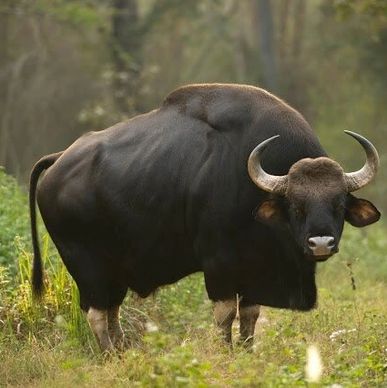
Manas National Park, situated in western Assam spreads over to Bhutan where it is called Royal Manas NP. The dense forest that alternates with alluvial grasslands, low alluvial savannah woodland and Assam valley semi-evergreen forest, provide a rich wilderness for a great variety of wildlife, including many endangered species.
Of the many varieties of Fauna in Manas, the three unique residents are the rare Pygmy Hog, the Hispid Hare and the Golden Langur, all in the endangered list. Dhole or the Asian Wild Dog is also found here. There are very good chances of spotting the Gaur or the Indian Bison. This is also a Tiger Reserve, so a tiger spotting you cannot be ruled out!! Apart from having a good chance of sighting herds of elephants, barking deer and capped langurs, watch out for the rare birds - Bengal Florican and the Great Hornbill. Other avian species include Jungle Fowls, Khaleej’s Pheasant, Eagles, Minivet, Osprey, Heron, Buzzard, Lapwing, Plover, Sandpiper, River Tern, Woodpeckers etc.
Wild life viewing: Recommended stay is for 3 nights/ 4 days in order to go over the different areas of the park including a safari to the Bhutanese border with the pretty sight of the Manas river flowing down from the hills. This World Heritage Site national park has been described by one British botanist as one of the most beautiful wildlife parks in India – both from its pristine beauty and, we are sure, from a botanist’s point of view due to the immense richness of its flora. Jeep safari is the best way to go deep inside the park. 4X4 open jeeps do a morning and afternoon safari with a break of 2 hours at noon. These safaris last for 3 to 5 hours each depending upon the daylight hours. An one hour elephant safari can also be done with prior booking days ahead of your visit. Naturalists and guides are provided from our side.
Namdapha National Park - Walking in Magical Wilderness
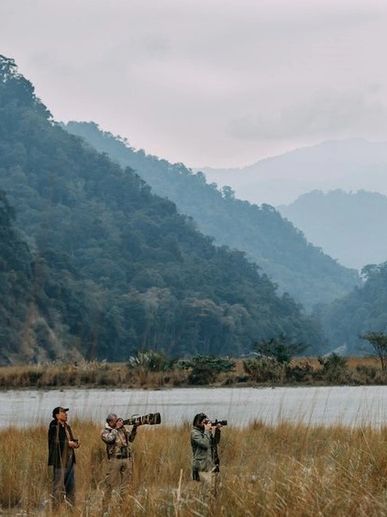
Namdapha is the most magical of Arunachal’s vast mountain forests. Gigantic trees, perpetual shaded areas because of the thick green canopy, meadows, bamboo thickets, rivers and streams all combine to make it a place deserving superlatives. The park, along with its surrounding forests is among the last large tracts of wilderness in south Asia. It is flanked to the south and east by the Patkai hills and to the north by the high mountain passes and peaks of the Himalayas. The Noa-dihing and the Namdapha rivers and numerous smaller streams flow through the 1,985 sq km of the greater Namdapha area. Namdapha was on the famous ‘hump’ air-route from Assam to China during the Second World War, and local people still occasionally stumble upon old crashes of allied aircraft in the hills.
Spanning 200 metres to over 4,500 metres above sea level, Namdapha is exceptionally diverse in its variety of habitats. Tall and dark evergreen rainforests cover vast areas of the lowlands, with subtropical and temperate forest in the mid elevations. Further up are stunted rhododendron forests and sub-alpine meadows. Bamboo forests and canebrakes are common, often in impenetrable thickets along streambeds. With such habitat diversity, an extraordinarily varied wildlife is no surprise. There are about a hundred mammal species, from the vocal hoolock gibbon to the elusive spotted linsang. Namdapha is the only park in India, and probably the world, with four large cat species – tiger, leopard, clouded leopard and snow leopard. At least 500 species of birds are recorded in Namdapha, including global rarities like the Snowy-throated Babbler, White-bellied Heron, Rufous-necked Hornbill and Ward’s Trogon. Despite Namdapha’s famed diversity, most species remain elusive due to the thick forest cover and also due to the very wide and varied terrain.
EITC may be contacted for taking out special permits for expeditions beyond the normal tourist circuit in case you want to trek to the upper reaches.
Wild Life Viewing: Recommended stay is for 5 nights/ 6 days for the normal circuit. Miao is the entry point to Namdapha National Park. From here the first stop is Deban, 20 km away that lies at the edge of the park. To go further into the park one needs to trek to different locations and stay in tented accommodation. On occasions elephants are used to cross over streams.
This birding/ nature trek is perhaps the best experience gained anywhere on the Indian soil. If you are inclined to take a bit of rough on your side Namdapha could be the nature trip you have been planning to do that is both rejuvenating and satisfying. We provide all tenting gear (please bring your own sleeping bag, if possible), porters, cooks, naturalists to accompany you.
We have more options on wildlife & birding tours, for details contact us on WhatsApp or email us.
You can combine two or more of the wildlife/birding itineraries given above or we can assist in designing your own program. Please feel free to write to
us at tours@eastindiatravel.in
Autumn, Winter, Spring Tours
Come Autumn and the possibilities open up for travel in India's Northeast. Active Holidays - treks & hikes, rafting, bicycle tours, wildlife safaris & birding tours are waiting to be experienced. Explore hidden tribal circuits, attend traditional festivals, immerse yourself in experiential travel, spend a few lazy days cruising the great Brahmaputra River. Autumn gives way to Winter and Spring and the tours continue up to mid May.
This website uses cookies.
We use cookies to analyze website traffic and optimize your website experience. By accepting our use of cookies, your data will be aggregated with all other user data.